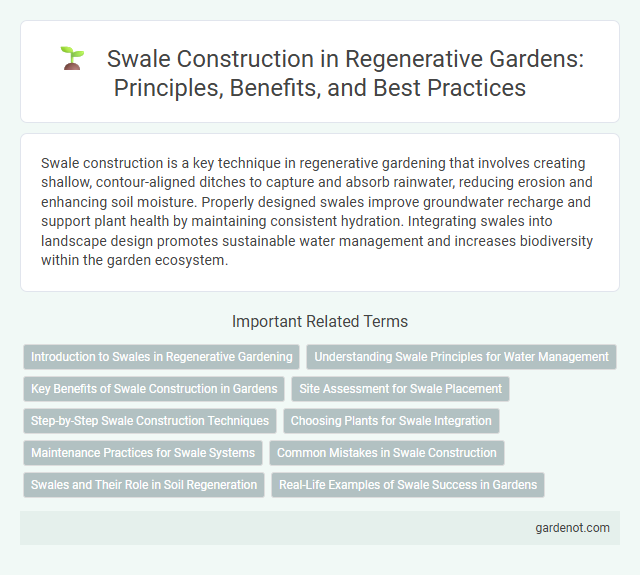Swale construction is a key technique in regenerative gardening that involves creating shallow, contour-aligned ditches to capture and absorb rainwater, reducing erosion and enhancing soil moisture. Properly designed swales improve groundwater recharge and support plant health by maintaining consistent hydration. Integrating swales into landscape design promotes sustainable water management and increases biodiversity within the garden ecosystem.
Introduction to Swales in Regenerative Gardening
Swales are shallow, hand-built channels designed to capture and infiltrate rainwater, reducing erosion and increasing soil moisture in regenerative gardens. By following the land's natural contours, swales slow runoff, allowing water to percolate into the soil and support plant growth. These earthworks enhance soil health, promote biodiversity, and contribute to sustainable water management in regenerative landscapes.
Understanding Swale Principles for Water Management
Swale construction involves creating shallow, strategically placed ditches designed to capture, slow, and infiltrate water runoff, thereby reducing erosion and promoting groundwater recharge. Understanding swale principles includes recognizing the importance of proper slope gradient, soil type, and vegetation choice to maximize water retention and filtration. These practices support sustainable water management in regenerative gardens by enhancing soil moisture levels and fostering healthy plant growth.
Key Benefits of Swale Construction in Gardens
Swale construction in regenerative gardens enhances water retention by capturing runoff and promoting deep soil infiltration, which reduces erosion and supports plant growth. This method improves soil moisture levels and nutrient cycling, fostering healthier ecosystems and increasing biodiversity. Implementing swales contributes to climate resilience by managing stormwater sustainably and mitigating drought effects in garden environments.
Site Assessment for Swale Placement
Site assessment for swale placement involves analyzing topography, soil type, and water flow patterns to determine the optimal location for water retention and infiltration. Evaluating slope gradients and identifying natural drainage pathways ensures swales effectively capture runoff and prevent erosion. Detailed soil permeability tests and vegetation surveys further guide placement, enhancing swale performance in regenerative garden ecosystems.
Step-by-Step Swale Construction Techniques
Step-by-step swale construction techniques begin with precise site assessment, identifying contour lines and water flow patterns to maximize water retention. Excavation follows, creating shallow, broad ditches along these contours, while the excavated soil is carefully heaped on the downhill side forming a berm that slows runoff and encourages infiltration. Planting native, deep-rooted vegetation on the berm stabilizes the soil, enhances water absorption, and promotes long-term regenerative garden health.
Choosing Plants for Swale Integration
Selecting native, drought-tolerant plants for swale construction enhances water retention and soil stabilization, vital for effective regenerative garden design. Deep-rooted species such as switchgrass and sedges improve infiltration while preventing erosion around swale edges. Integrating a diverse plant palette including nitrogen-fixers like clover boosts soil fertility and supports local biodiversity within the swale ecosystem.
Maintenance Practices for Swale Systems
Effective maintenance of swale systems involves regular inspection and removal of sediment buildup to ensure proper water infiltration and prevent blockage. Vegetation within swales should be monitored and managed through selective trimming or replanting native species to maintain soil stability and enhance pollutant filtration. Periodic evaluation of swale slopes and structural integrity helps avoid erosion and supports sustained water flow management in regenerative garden landscapes.
Common Mistakes in Swale Construction
Common mistakes in swale construction include improper grading that disrupts water flow, leading to erosion or waterlogging. Using incorrect soil types without adequate filtration can result in poor water retention and nutrient distribution. Failing to account for local topography and vegetation needs often reduces the swale's effectiveness in managing stormwater and supporting regenerative ecosystems.
Swales and Their Role in Soil Regeneration
Swales are shallow, contour-aligned trenches designed to capture and infiltrate rainwater, reducing erosion and recharging groundwater in regenerative gardens. By slowing water runoff, swales enhance soil moisture levels and promote the activity of beneficial microorganisms critical for nutrient cycling and soil structure improvement. Their integration into permaculture landscapes supports soil regeneration by maintaining hydration, increasing organic matter retention, and preventing nutrient loss.
Real-Life Examples of Swale Success in Gardens
Swale construction creates contour ditches that capture and direct rainwater, preventing erosion and promoting soil hydration in regenerative gardens. In real-life examples, permaculture farms in California have seen improved plant growth and reduced irrigation needs by implementing swales, while urban garden projects in Australia report thriving native vegetation and enhanced biodiversity. These practical applications demonstrate swales' effectiveness in water management and ecosystem restoration within diverse garden settings.
Swale construction Infographic

 gardenot.com
gardenot.com